Several variations exist for this exercise. Bicep curls can be performed either seated or standing, using free weights, barbells, resistance bands, or machines. If standing, the postural muscles, particularly the abdominals and low back are utilized to a greater degree than if seated. The cumulative effect of standing exercises shows up in improved balance and overall core strength and should be considered a good option for those who normally sit most of the day.
Starting position: Hold weights in each hand, arms straight and next to your sides, palms facing forward. To prevent the shoulders from rolling forward, pull the shoulder blades slightly together and down. This is the lengthening phase of the exercise.
Contraction Phase: Keeping the upper arms in place and maintaining an erect posture, slowly bring the weights toward the shoulders.
Return to the starting position by lowering the weights in a slow and controlled manner.
Variations:
Hammer curls: Instead of palms facing the front of the body, turn them inward, so that they face your sides as you lift and lower.
Preacher curls: With this variation, a preacher curl machine or other sloped surface is used. Here, the elbows are in front of the body and the upper arms are fully supported as the weight is lifted. If attempting this version, stabilize the torso, and avoid overextending the arms, which will put needless strain on the elbow joint.
Concentration curls: This variation is performed seated, holding a dumbbell in one hand. The upper body leans forward slightly, with the elbow placed on the inside of the same side knee, arm straight. Lift the dumbbell upward towards the shoulder while keeping upper arm still. Pause briefly and then slowly lower.
21s: With this version, the weights are lifted half way up for 7 repetitions, then lowered half way down for 7 repetitions, and to complete the set 7 full bicep curls are performed. Resistance used will be lighter than with other forms of curls in order to complete all 21 repetitions.
For safety, if you are unaccustomed to exercise or have joint problems, it is advisable to get clearance from your doctor beforehand. Begin with weights that allow you to perform 8 to 12 repetitions before reaching full muscle fatigue, 2 to 3 sets, every other day. Increase resistance as strength improves. It can also be very helpful to have a spotter assist you until you feel comfortable with form and weight load.
Marjie Gilliam is an International Sports Sciences Master certified personal trainer and fitness consultant. She owns Custom Fitness Personal Training Services LLC. Send email to marjie@ohtrainer.com.
Credit: Getty Images
Credit: Getty Images
About the Author

